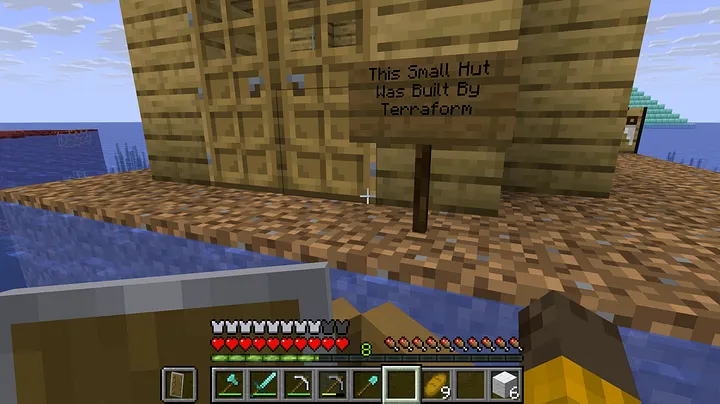Terraforming Minecraft: Primitives
Terraform is widely known for managing cloud infrastructure, but what if we turned it toward a very different kind of terrain — Minecraft? As an avid Minecraft player and someone fascinated by automation, I’ve been experimenting with the Minecraft Terraform provider, a quirky yet surprisingly powerful way to control the Minecraft world through code.
In this post, I’ll walk through how I used Terraform modules to automate the construction of a 4x4 log cabin. To build it, I started with some basic, reusable primitives — a pillar and a cuboid — which let me stack and compose Minecraft blocks in a highly structured way.
Minecraft as a Control Plane for Terraform
Using Terraform to build in Minecraft is more than just a novelty. It allows you to codify structures, experiment with automation patterns, and even think of the game world as a control plane layered on top of the Azure infrastructure it is hosted on. Instead of manually placing each block, you define a configuration and let Terraform do the work.
At its core, the Minecraft Terraform provider lets you place blocks by specifying their coordinates and material type. From there, the rest is just a matter of abstraction through Terraform module development.
Primitive #1: The Pillar Module
The pillar module creates a vertical line of blocks starting from a given position. This primitive is especially useful for building columns, walls, or anything that repeats along the Y-axis.
Inputs
variable "material" {
description = "The block material to use (e.g. minecraft:dirt)"
type = string
}
variable "start_position" {
description = "The starting x, y, z position of the pillar"
type = object({
x = number
y = number
z = number
})
}
variable "height" {
description = "The number of blocks tall the pillar should be"
type = number
}
Block Placement Logic
The logic here generates a list of Y positions based on the specified height, and places a block at each one:
locals {
y_positions = [
for i in range(var.height) : tostring(var.start_position.y + i)
]
}
resource "minecraft_block" "pillar" {
for_each = toset(local.y_positions)
material = var.material
position = {
x = var.start_position.x
y = each.value
z = var.start_position.z
}
}
This compact module becomes the foundation for more complex structures.
Primitive #2: The Cuboid Module
To build solid shapes like walls, floors, or chunks of a cabin, I created a cuboid module, which is essentially a 3D rectangle composed of vertical pillars.
Inputs
variable "material" {
type = string
}
variable "start_position" {
type = object({
x = number
y = number
z = number
})
}
variable "width" {
type = number
}
variable "height" {
type = number
}
variable "depth" {
type = number
}
Block Placement Logic
Rather than manually creating every block, I leveraged the pillar module. First, I generated offsets for the base XZ plane, and then used those to spawn a grid of vertical pillars.
locals {
positions = flatten([
for x in range(var.width) : [
for z in range(var.depth) : {
x_offset = x
z_offset = z
}
]
])
}
module "pillars" {
for_each = {
for pos in local.positions :
"${pos.x_offset}-${pos.z_offset}" => pos
}
source = "../pillar"
material = var.material
height = var.height
start_position = {
x = var.start_position.x + each.value.x_offset
y = var.start_position.y
z = var.start_position.z + each.value.z_offset
}
}
This approach keeps the code DRY (Don’t Repeat Yourself) and makes the cuboid structure scalable and easy to tweak.
Building the Log Cabin
With these two primitives — pillar and cuboid — I was able to construct a small 4x4 log cabin entirely in code. The cuboid module helped me define the walls and roof, while individual pillars gave finer control for corners and accents. Best of all, I can now spin up this cabin in any location just by changing the start_position.
Why Automate Minecraft?
Admittedly, this isn’t the most “practical” use of Terraform in the traditional DevOps sense. But it is fun, and it’s a great sandbox for thinking about automation in a new way. Writing infrastructure as code is one thing — but writing structures as code is something else entirely.
If you’re a Minecraft fan and enjoy experimenting with infrastructure tools, give this a try. It’s a new kind of control plane: one that runs on dirt blocks and redstone.
Conclusion
Terraforming Minecraft isn’t just a clever pun — it’s a genuine exercise in programmable creativity. By building reusable primitives like pillars and cuboids, I’ve begun constructing an automated world one block at a time. And the possibilities go far beyond a cabin: towers, castles, redstone labs — all programmable, all reproducible.
Whether you’re learning Terraform, building in Minecraft, or just looking for an offbeat coding project, this is a strangely satisfying way to blend play and precision.
